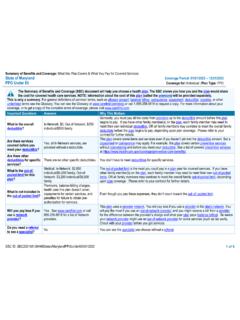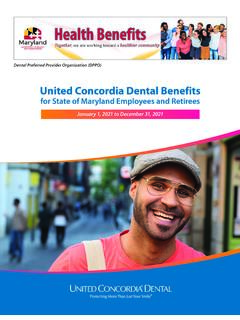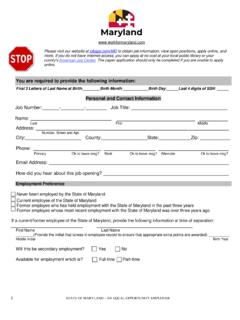Transcription of FY 2022 Operating Budget Highlights - Department of …
1 F Y 2021 MARYLAND Budget HIGHLIGHTSMARYLAND Budget HIGHLIGHTSM aryland Budget Highlights FISCAL YEAR 2022 LAWRENCE J. HOGAN, JR., GOVERNOR BOYD K. RUTHERFORD, LIEUTENANT GOVERNOR January 20, 2021 Te Honorable Bill Ferguson and the Maryland State Senate Te Honorable Adrienne A. Jones and the Maryland House of Delegates Te People of Maryland Dear Mr. President, Madam Speaker, Members of the Maryland General Assembly, and Fellow Marylanders: Tis letter has customarily been used to tout the primary investments in the governor s forthcoming Budget proposal and to highlight the aspects of state government that the administration has decided to fund as part of their vision for the future of Maryland and her citizens. No discussion about FY 2022 can begin, however, without frst highlighting the enormous public health and economic challenges our state and country have faced over the past year.
2 Every priority in my proposed Budget must be viewed through this lens. By the time the frst known cases of coronavirus were identifed in Maryland last March, we knew that the key to containment was swif and decisive action, so I acted immediately to limit the size and nature of all public gatherings and to encourage the scientifcally proven social distancing guidelines in an attempt to control the spread of the disease and to ultimately save Marylanders lives. Our goal was simple fatten the curve and our tough, commonsense policies accomplished that before the start of summer. In addition to this public health crisis, we were also challenged by a historic economic decline. Hundreds of thousands of hardworking Marylanders lost their jobs in a matter of days as our country locked down to prevent the spread. Our economic outlook was dire. In order to meet our needs, I froze state spending and implemented a series of targeted but signifcant reductions as part of a larger Budget balancing plan to prevent a massive shortfall in the fnal days of FY 2020 and set us on on a path toward achieving balance in our current Budget without the need to implement widespread layofs or furloughs.
3 To put it simply: our plan worked. Our state economy didn t experience the drastic downturn expected by leading national economists, and we now face defcits that pale in comparison to the initial doomsday predictions. Te combination of our immediate initial steps, the emergency aid we distributed, and our cautious but determined path to reopening our economy improved the state s fscal outlook dramatically. Initial estimates had refected potential revenue losses of up to $ billion in the fscal year ending last June, $ billion in FY 2021, and a massive $4 billion in the new Budget year a drop that would have completely wiped out our past six years of economic growth. Instead, FY 2020 ended roughly $100 million short of our budgeted revenues, and the most recent projections estimate that we will only lose a combined, but still signifcant, $921 million over the next two fscal years. Without this turnaround, the following Budget would have looked quite diferent.
4 As it stands, however, I am proud to present my FY 2022 Budget proposal a document that provides record investments for all of our key Budget priorities without jeopardizing our economic recovery by increasing taxes on those very Maryland citizens and businesses that have been responsible for our recovery. Te FY 2022 Budget marks the third year that the Hogan Lockbox has allocated gaming revenue to supplement the education funding formulas putting an additional $375 million where it was always meant to go: into schools and classrooms throughout the state.
5 All in all, a record $ billion will be invested in Maryland s public school system this year. Our dedication to K-12 education continues in our FY 2022 capital plan as well, with a record $803 million going toward school construction projects in every jurisdiction. Tis historic commitment to putting our students into state-of-the-art facilities no matter where they live is made possible only by our unique plan to issue revenue bonds using a portion of the funding casinos bring into the state. Roughly $ billion dollars combined will be spent between the Operating and capital Budget on higher education in this Budget . Tis funding will ensure that any student who wishes to pursue a college or university degree will have access to the highest quality institutions and world-class programs across the professional spectrum. And for the sixth year in a row, this will all be kept afordable because we are once again limiting tuition growth at state colleges and universities to 2%.
6 Tis Budget also aims to stimulate our economy with the implementation of our recently announced $1 billion COVID-19 relief package. Tis combination of tax cuts and direct stimulus payments to eligible low-income Marylanders will jumpstart spending, spur job growth, and incentivize people to get back and spend in their local communities as the dissemination of the COVID-19 vaccines makes it safer and less burdensome to do so. All this public investment wouldn t be worthwhile, however, if we jeopardized the environment and our state s beautiful natural resources in the process. Tat is why, for the sixth consecutive year, we have fully funded Chesapeake Bay restoration eforts and made sure that all state environmental protection programs funded by the transfer tax are fully funded as well the fourth year in a row we can claim that accomplishment. Tough we have been struck by a more public crisis, I feel it important to remind you all that the Hogan administration has not forgotten about the silent epidemic that still threatens the lives of Marylanders every day: opioid abuse and other substance use disorders.
7 In order to combat this ongoing threat, we have once again provided record funding for residential substance abuse treatment. Spending in this area has increased 562% since FY 2016, but the war is still not won. Perhaps the biggest accomplishment of all with this Budget is the fact that we have managed to include all this funding and provide signifcant tax relief without cutting services all while preserving approximately $ billion in our cash reserves, which is a major factor in maintaining the state s highly coveted AAA bond rating. I am proud that the entire executive branch understands the importance of practicing the kind of fscal discipline required to make this possible year afer year. And I am proud that we will have the opportunity to work with you this legislative session as we strive for new ways to continue changing Maryland for the better. Sincerely, Larry Hogan Governor Table of Contents Revenues 6 Expenditures 7 COVID-19 Response 8 Budget in Brief 13 Quality of Life 17 Public Health and Safety 21 Economic Development and Jobs 24 Capital Budget 28 Capital Budget for Transportation 34 Supporting Local Government 37 Appendices 51 Some totals and percentages in this book may not add due to rounding.
8 RevenuesOther General Funds 4% Federal Fund Revenue 31% Individual Income Tax 23% Sales Tax 11% Higher Education Revenues 10% Transportation Revenues 4% Corporate Income Tax 3% Fuel Taxes 2% Lottery 1% Other Special Funds 11% % Change % Total Revenues (Millions of $) FY 2020 FY 2021 FY 2022 22 over 21 Revenues Federal Fund Revenue 14,960 17,033 15,379 -10% 31% Individual Income Tax 10,699 10,850 11,316 4% 23% Sales Tax 4,937 5,211 5,447 5% 11% Higher Education Revenues 4,533 4,710 4,671 -1% 10% Transportation Revenues 1,962 1,864 2,103 13% 4% Corporate Income Tax 1,325 1,341 1,498 12% 3% Fuel Taxes 1,070 1,040 1,047 1% 2% Lottery 666 728 717 -1% 1% Other Special Funds 5,227 6,149 5,144 -16% 10% Other General Funds 1,700 1,551 1,774 14% 4% TOTAL REVENUES 47,079 50,477 49,096 -3% Earned Income Tax Credit - Rebate for Tax Year 2019 (178) 0 Earned Income Tax Credit - Rebate for Tax Year 2020 (89) 0 Enhanced Vendor Discount (300) 0 Hometown Heroes 0 (7) Lottery Revenue (3) (1) Maryland Health Exchange 0 3 MDH Disproportionate Hospital Share 7 10 Military Retirement Income 0 (18) Phase-in Revenue Volatility 0 80 Research and Development Tax Credit 0 (7)
9 UI Tax Forgiveness (50) (20) Maryland Environmental Service Refund 2 0 TOTAL AVAILABLE 47,079 49,867 49,136 -1% 6
10 Expenditures Legislative, Judicial, Legal Other Reserve Fund He a lt h 35% Elementary and Secondary Education 18% Higher Education 14% Transportation 10% Human Resources 7% Public Safety 5% Public Debt 3% Natural Resources and Environment 2% 2% 4% 0% % Change % Total Expenditures (Millions of $) FY 2020 FY 2021 FY 2022 22 over 21 Expenditures Health 15,537 16,593 17,348 5% 35% Elementary and Secondary Education 8,795 9,117 9,034 -1% 18% Higher Education 6,788 6,994 6,901 -1% 14% Transportation 5,373 5,133 4,889 -5% 10% Human Resources 3,210 4,225 3,264 -23% 7% Public Safety 2,437 2,570 2,521 -2% 5% Public Debt 1,322 1,345 1.









